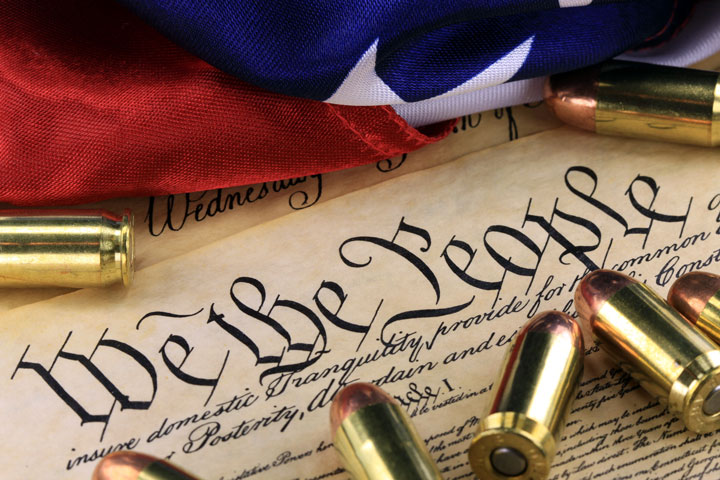Nurses have a role to play in assessing, educating, intervening, and advocating.
Takeaways:
- Whether a history of mental illness caused a specific shooting or that a psychiatric evaluation might prevent shootings is a complicated issue.
- Whether an individual with a mental illness should have a firearm is a controversial, debatable, and contentious issue.
- If a nurse in the home of a client feels unsafe and suspects the client may a firearm, he or she should leave immediately and call 911.
In response to school shootings and other gun violence, many people are calling for a reexamination of the Second Amendment of the U.S. Constitution in relation to people who are mentally ill. The Second Amendment states: “A well regulated Militia, being necessary to the security of a free State, the right of the people to keep and bear Arms, shall not be infringed.” Differing interpretations of the Amendment have caused considerable debate about its intention, but I can’t imagine that anyone believes it condones mass shootings. And I believe that most people agree that individuals who’ve demonstrated violent tendencies or those with a significant history of mental illness shouldn’t have access to weapons. However, the idea that a history of mental illness caused any specific shooting or that a psychiatric evaluation might prevent shootings is a more complicated issue, as is whether an individual with a mental illness should have a firearm.
Historical treatment of people with mental illness
The history of mistreatment of people with mental illness is well–documented, and their rights are at issue as it relates to their right to bear arms. On October 31, 1963, President John F. Kennedy signed into law the Community Mental Health Act, which was enacted, in part, in response to the poor treatment of people with mental illness. The Act drastically changed how the United States delivers mental health services. It funded the establishment of comprehensive community mental health centers, providing outpatient services and alternative/community living arrangements for people with mental illnesses as they were released from “asylums.” The Act was the beginning of proper treatment and advocacy for the rights of those with mental illness.
Calls for action after mass shootings
Mass shootings understandably cause public outrage, and the media quickly diagnose the shooter with a mental illness. However, White, in a 2017 Defense Counsel Journal article, states that many perpetrators of mass shootings have no history of involuntary psychiatric hospitalization. White states that “although some mass shooters are found to have a history of a psychiatric illness, no reliable research has suggested that a majority of perpetrators are primarily influenced by serious mental illness.”
Public outrage after a tragic mass shooting frequently leads to calls for gun control, including restrictions on gun ownership by people with mental illness. Appelbaum and White assert that less than 3% to 5% of U.S. crimes are committed by individuals with a mental illness, and that gun control laws targeting this group that would produce a low volume of offenders, be ineffective, and waste sparse resources. The American Psychiatric Association (APA) calls for research, data analysis, and gun access restrictions as a way to address the real issue: the inherently unsafe product, not the person. (See APA statement on gun deaths and injuries.)
APA statement on gun deaths and injuriesMany deaths and injuries from gun violence can be prevented through national and state legislative and regulatory measures. Recognizing that most gun violence is not attributable to mental illness, the American Psychiatric Association (APA) views the broader problem of firearm-related injury as a public health issue and supports interventions that reduce the risk of harm. Actions to minimize firearm injuries and violence should include:
|
Laws, policies, and positions
The U.S. National Instant Criminal Background Check System (NICS) identifies individuals who aren’t eligible to purchase firearms. It includes information about an individual’s criminal and mental health histories as well as civil orders against them that might affect their ability to purchase or possess a gun. An individual who receives mental health treatment is not automatically prohibited from having a firearm.
On January 4, 2016, the Department of Health and Human Services (HHS) modified the Health Insurance Portability and Accountability Act (HIPAA) Privacy Rule to permit certain entities to disclose to the NICS those individuals who, for mental health reasons, already are prohibited by federal law from having a firearm. The Consortium for Risk-Based Firearm Policy, in their report Guns, Public Health and Mental Illness: An Evidence-Based Approach for State Policy, notes that although major mental illnesses are associated with increased risk of violent acts, gun policies targeted to this group alone would be ineffective at reducing violence. The Consortium agrees that updates to the federal firearm disqualification criteria are needed as it relates to mental health, and it concludes that as opposed to focusing solely on mental health history, future policy should use evidence–based criteria to disqualify individuals.
Another safeguard is Red Flag Laws (also known as Extreme Risk Protection Orders or Gun Violence Restraining Orders) that permit relatives, close friends, or others, as well as law enforcement to petition a court to temporarily take guns from people who pose a danger to themselves or others. These laws, which have been enacted in 10 states, allow guns to be removed from someone in a “temporary crisis.” A temporary crisis is defined as a stressful time when an individual may not be thinking clearly or is experiencing a disruption in his or her usual activities of daily living or functioning. If the court grants the order, the weapons are immediately seized. The order expires in 1 year, and it can be renewed if a judge is convinced that the risk remains.
The National Alliance on Mental Illness (NAMI), a nationwide grassroots advocacy group that represents people (usually loved ones) affected by mental illness recognizes that “acts of violence by people with mental illness are usually the result of lack of needed mental health services.” The group also states that enacting gun laws based on mental illness could create barriers for the mentally ill to seek treatment and help when it’s most needed. NAMI reports that research on the relationship between mental illness and violence demonstrates that several factors may increase the risk of violence among a small number of individuals with mental illness. These factors include:
- co-occurring misuse of alcohol or illegal drugs
- past history of violence
- being young and male
- untreated psychosis.
Despite these laws and policies, private sellers aren’t required to perform background checks, creating a loophole in the process.
Nurses’ role
Nurses can contribute to public safety by assessing individuals for mental illness, educating patients and their families, intervening in crisis situations, and advocating for mental health funding and commonsense laws.
Assessment
Privacy and trust are valued tenets in the nurse-client relationship, but safety is paramount. If during a patient assessment you identify a patient with mental illness who may cause harm to self or others, you’re permitted to disclose this information to the NICS or other authorities without violating HIPAA privacy rules.
Education
When caring for a patient with mental illness, educate him or her and the family about treatment options and support services. In addition, seek out education for yourself about safe firearm use and storage so that you can share relevant information with patients.
Intervention
When assessing a patient who is in crisis, ask if a gun is in the home. If the individual presents in crisis to a healthcare facility, contact the authorities so the weapon can be removed from the home to keep the client and public safe. If you’re in the home with the patient, contact law enforcement to remove any firearms. When planning a visit to a client who you suspect has a firearm, you can ask your employer or the police to provide an escort. When you’re in the home, ensure you have access to an exit and don’t place yourself in corner. If you ever feel unsafe in a patient’s home, leave and call 911.
Advocacy
Funding for mental health services and resources has been dramatically cut. You can lobby for restoration of these services, including community–based psychiatric care, housing for people with mental illnesses, and affordable access to medications. The American Psychiatric Nurses Association (APNA) calls on policymakers to increase student access to nurses and mental health professionals from elementary school through college. The APNA also calls for a ban on assault weapons and the enactment of other meaningful gun control reforms. You can advocate for enforcing current gun laws and efforts to ensure background checks for all gun sales, including private sales.
In addition, you can advocate for policies and programs that support the rights of people with mental illness while also ensuring public safety. In advocating for the rights of people with mental illness, you can advocate for more evidence–based research to inform gun policies.
A balanced approach
The Dickey Amendment, passed in 1996, mandates that “none of the funds made available for injury prevention and control at the Centers for Disease Control and Prevention (CDC) may be used to advocate or promote gun control.” This amendment was created after the National Rifle Association lobbied Congress in response to a 1993 CDC-funded study that reported that guns in the home are associated with increased risk of homicide in the home.
Research on guns and gun violence must be data-driven so that balanced solutions can be implemented to protect everyone’s rights. Researchers have had this to say on the issue:
- Funding for research on gun violence must overcome the political barriers that prevent sound, evidence–based research of the data necessary to study this public health crisis (Frankel 2015).
- Barriers to federal support for research on firearms violence and deaths should be removed (Pinals et al., 2015).
Barbara Blozen is an associate professor of nursing at New Jersey City University in Jersey City.
Selected references
Appelbaum PS. Violence and mental disorders: Data and public policy. Am J Psychiatry. 2006;163(8):1319-21.
Frankel TC. Why the CDC still isn’t researching gun violence, despite the ban being lifted two years ago. Washington Post. January 14, 2015.
Guns, Public Health, and Mental Illness: An Evidence-Based Approach for State Policy. Consortium for Risk-Based Firearm Policy. 2013. efsgv.wpengine.com/wp-content/uploads/2014/10/Final-State-Report.pdf
HIPAA privacy rule and the National Instant Criminal Background Check System (NICS). Health and Human Services. June 16, 2017. hhs.gov/hipaa/for-professionals/special-topics/nics/index.html
Pinals DA, Appelbaum PS, Bonnie R, Fisher CE, Gold LH, Lee LW. American Psychiatric Association: Position statement on firearm access, acts of violence and the relationship to mental illness and mental health services. Behav Sci Law. 2015;33(2-3):195-8.
Rubin R. Mental health reform will not reduce US gun violence, experts say. JAMA. 2016;315(2):119-21.
Shenon P. Fear and brutality in a Creedmoor ward. The New York Times. June 18, 1984. nytimes.com/1984/06/18/nyregion/fear-and-brutality-in-a-creedmoor-ward.html
Swayze VW. Frontal leukotomy and related psychosurgical procedures in the era before antipsychotics (1935-1954): A historical overview. Am J Psychiatry. 1995;154(4):505-15.
There’s something states can do about gun violence: ‘Red-flag’ laws. Washington Post. March 1, 2018.
Van Gijn J. Mad in America: Bad science, bad medicine, and the enduring mistreatment of the mentally ill. New Engl J Med. 2002;346:2096.
Violence and gun reporting laws. National Alliance on Mental Health. nami.org/Learn-More/Public-Policy/Violence-and-Gun-Reporting-Laws
Wexler L. Gun shy. Hopkins Bloomberg Public Health. 2017. magazine.jhsph.edu/2017/fall/features/cassandra-crifasi-hopkins-moderate-gun-owner-gun-policy-researcher/how-the-dickey-amendment-affects-gun-violence-research.html
White TJ. Shots fired—A rational assessment of mass shootings, the alleged participation of the mentally ill, and an impaired right of privacy. Def Couns J. 2017;84(3). iadclaw.org/publications news/defensecounseljournal/shots-fired—a-rational-assessment-of-mass-shootings-the-alleged-participation-of-the-mentally-ill-and-an-impaired-right-of-privacy/


















